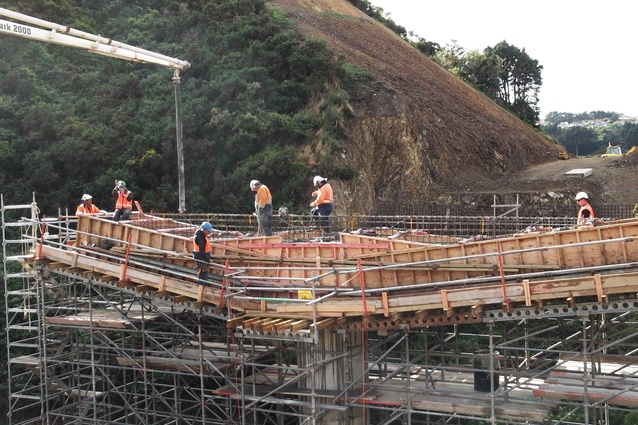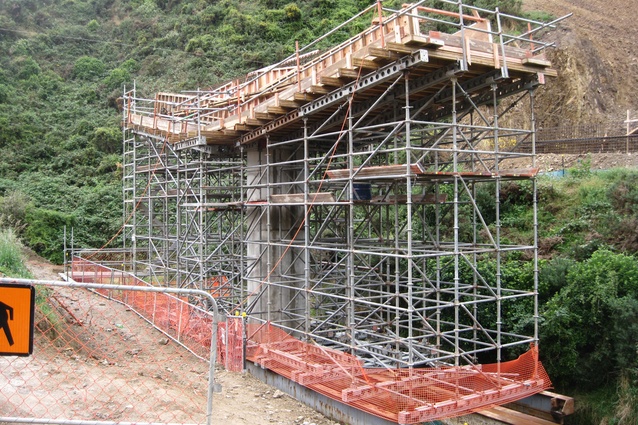Westchester Drive extension
A complex and compact project, the Westchester Drive extension in Wellington’s Churton Park comprises two bridges, a stream, steep terrain and retaining walls. All in an 850 metre stretch of road.
Big cuts for a small road are making temporary marks on the land in Churton Park, Wellington. The green field site is compact and complex with many different elements for engineering designers, MWH and contractors Fulton Hogan to work with. The project comprises approximately 850 metres of new road and Fulton Hogan project manager Duncan Mundell says the multifaceted project is unusual.
“Normally you get a bridge job where you’ll build a small abutment and maybe a bit of road or a wall. But this has the whole gambit – two bridges and a stream [including small fish and eels], steep terrain, retaining walls and neighbours. There’s probably more complex work on this than on some 10 kilometre projects.”
The immediate banks of Stebbings Stream look relatively untouched by the massive earthworks. Environmental protection is an important factor in the Wellington City Council’s (WCC) Westchester Drive link road project that fulfils eight regional council resource consents. At least eight alignment options have been considered for this project since first conception, one of which enclosed the stream in a culvert and put the road straight through to Middleton Road in Glenside.
Evolving professional and public attitudes towards the environment have influenced the various options since the road was designated in the transitional district plan in 1992. Residents of semi-rural Glenside, who will now have more traffic past their doors, wanted the environment and ecology of the stream to be respected. WCC took their concerns on board. As the capital city grew north, road access to the new suburb and motorway became a pressing issue. In long term planning for the area WCC wanted a link road between Broadmeadows and Glenside to give an alternative route onto the motorway through Johnsonville.
 Halswater Drive has been the main road access to Churton Park, from Middleton Road, carrying up to 8000 vehicles per day. Residents were concerned about safety and congestion. “[Halswater Drive] is probably right up there in terms of what it was ever built for, or ever imagined to take,” says the client’s (WCC) engineer, Stephen Harte. With potential for 800 houses in Stebbings Valley, alternative access was needed. A New World supermarket opened recently in Westchester Drive and other community amenities will follow suit. Fulton Hogan began from the middle of the site and worked outwards.
Halswater Drive has been the main road access to Churton Park, from Middleton Road, carrying up to 8000 vehicles per day. Residents were concerned about safety and congestion. “[Halswater Drive] is probably right up there in terms of what it was ever built for, or ever imagined to take,” says the client’s (WCC) engineer, Stephen Harte. With potential for 800 houses in Stebbings Valley, alternative access was needed. A New World supermarket opened recently in Westchester Drive and other community amenities will follow suit. Fulton Hogan began from the middle of the site and worked outwards.
The Churton Park end and western bridge abutment were begun reasonably early where access was easy, then they worked towards the eastern abutment. Mundell says they follow consent guidelines and conditions to the letter, respecting both neighbours and wildlife. Silt fencing protects the stream from silt and concrete spills and they have built across the top of the stream rather than dig into it. “At the end of the day that stream will be in as good condition as when we turned up,” Mundell says.
The stream was diverted in one corner, taking into account 11 eels, hand reared by a local property owner. A couple of the eels are around 40 years old and since the project began have possibly left for breeding grounds in the Pacific Ocean. Two standard bridges takes the road across two streams. The western bridge comprises a 40m twin span, double hollow core deck on piled abutments. Each abutment is supported on four 750mm diameter piles socketed into the greywacke bedrock substrata.
The western approach embankment is supported on a mechanically stabilised earth (MSE) retaining wall. The pre-stressed, pre-cast beams span onto the crosshead (central pier), then fly across Stebbings Stream to the east abutment. The 20m eastern bridge is single span, double hollow core deck and crosses the Porirua Stream at Middleton Road. MWH’s principal bridge engineer, Jeremy Walters, says the main challenges from a design perspective have emerged during the course of construction, however this is not unusual when working next to a water course with a predominantly earthworks’ solution. On the eastern side a single span bridge is currently under construction; there they found a dormant fault, which splinters off the Ohariu Valley fault.
The bridge abutment had to be quickly redesigned accordingly. “That bridge has revolved in a complete mirror flip,” Walters says. “Originally we had piles on one side of the stream and a sill beam on the other. Then we came across this unmapped fault and flipped it over. When we got to the other side, we found there was a bit of an existing gully and five metres of silt.”
This was more than expected and required specific geotechnical site investigation and longer piles. Typical of Wellington, the terrain is steep and requires erosion and sediment controls; the topography accentuates the height of the cuts. To minimise the effect on the environment WCC narrowed the two-carriageway road with a footpath along the stream side, adding curves to follow the topography, and to reduce the amount of stream diversion work. In areas of separation between the stream and the road swales will filter runoff into the stream from the road. “
Where we haven’t been able to do that we have added treatment to the stormwater to maintain quality,” says Harte. “When you cut those faces and put a road in you get quicker runoff of water so we are trying to slow it down. Also with the cars running on it you are trying to stop the pollutants from cars and oil and so on. That’s an extra level of attention we paid on this particular job.”
The greywacke is heavily fractured, more than expected. MWH redesigned the slopes and the resource consent took two months to resolve. Originally making one in one cuts (45 degrees) they are now cutting the slopes back one in two (26.6 degrees). With challenge comes opportunity. Standing above the third, seven-metre high retaining wall, Walters says the fractured greywacke rock has worked wonders for the project.

“That’s why we chose this type of wall [MSE] because it’s all site won material. We haven’t imported any of this fill, it’s all come out of the hills.” Graded greywacke rock is compacted behind a vertical precast concrete panel, which is tied back in under the proposed road with galvanised steel straps up to eight metres long, held in place by the weight of the fill. The method of construction works particularly well in a watercourse environment because the contractor and equipment always work behind the wall, thus minimising any environmental impact. It is also a very quick method of construction. The wall panels are an exposed aggregate finish with cruciform design chosen to fit with the local environment. Riprap (rocks) stops the stream eroding beneath the walls. Available on-site fill has saved money and lessened environmental impact, dust and noise from trucks.
The bare hillsides will be sprayed with hydro-seed and landscaping and planting plans have been done by Boffa Miskell; the company also monitors and reports on stream condition. Mundell says working with local groups has helped in getting information out first hand to the community and there have been few complaints. Construction started in earnest in May last year and they expect to be finished by Christmas 2012 within the budget of $8 million.
The figure includes some additional costs for earthworks that have been managed within the overall scope and budget of the project. Over the next five years WCC will work to re-establish the cut faces and do riparian planting, which will reduce the current visual intrusiveness of the road. Environmental awareness is part and parcel of modern day projects, says Walters.
“It’s one of the first things you think about when you design your projects – how can we make this impact as little as possible on the surrounding environment?”












